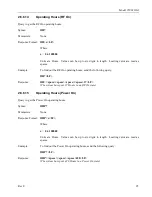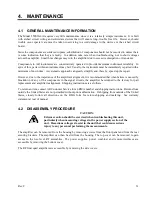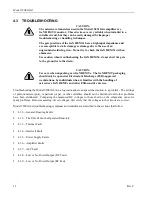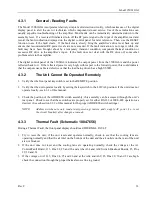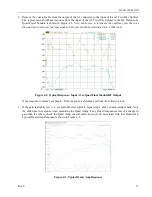
Model 350S1G6A
Rev C
33
4.3.1
General - Reading Faults
The Model 350S1G6A incorporates relatively simple fault detection circuitry, which makes use of the digital
display panel to alert the user or technician which component(s) need service. Use of these indications can
usually expedite troubleshooting of the amplifier. Most faults can be immediately determined down to the
assembly level. If a reset is still indicated, turn off the RF power signal to the input of the amplifier, read and
record the fault indication displayed on the digital control panel for later reference. Then, use the
RESET
function
to see if the fault clears. If the fault clears, slowly bring the amplifier’s drive level back up and
ensure that recommended RF power levels are not exceeded. If the fault indication is no longer visible, the
fault may have been brought about by a temporary transient condition, component thermal condition or
excessive RF drive to the amplifier’s input. If the fault does not clear with the RF drive off, some other
problem exists in the amplifier.
The digital control panel of the 350S1G6A indicates the output power from the 350S1G6A and the power
reflected back to it. If the reflected power is very high, with respect to the forward power, this could indicate
that the output coax cable is defective or that the load being driven has a high VSWR.
4.3.2
The Unit Cannot Be Operated Remotely
1.
Verify that the front panel keyswitch is set to the REMOTE position.
2.
Verify that the unit operates locally by setting the keyswitch to the LOCAL position; if the unit does not
operate locally, see 4.3.1 of this manual.
3.
Check the position of the ADDRESS switch assembly; this assembly can be accessed through the unit’s
rear panel. Check to see that these switches are properly set for either RS-232 or IEEE-488 operation, as
desired. (See subsection 2.2.2 of this manual for the proper ADDRESS switch settings.)
NOTE:
Address switches are only read at unit power-up; remove and re-apply AC power (i.e., reset
the circuit breaker) after changes are made.
4.3.3
Thermal Fault (Schematic 10047656)
During a Thermal Fault, the front panel display should read THERMAL FAULT.
1.
Try to reset the unit; if the unit resets and operates normally, check to see that the cooling fans are
operating normally and that the air inlet on the bottom of the unit and the air outlets on the rear of the unit
are not blocked.
2.
If the unit does not reset and the cooling fans are operating normally, check the voltage at the A1
Control/Fault Board, J13, Pins 24, 25 and 26 and at the A64 and A69 Switch Breakout Boards, J5, Pins
29, 30 and 31.
3.
If the voltage on A1 J13, Pins 24, 25 and 26 and at the A64 and A69, J5, Pins 29, 30 and 31 are high,
check the connection through the proper thermal sensor line to ground.







